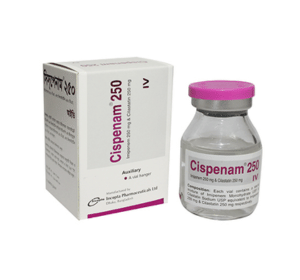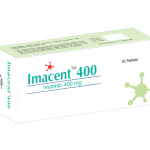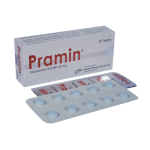Cispenam(Imipenem & Cilastatin)

Therapeutic Group: Anti Bacterial
Presentation
Cispenam 250 IV injection: Each vial contains a sterile mixture of Imipenem (as Monohydrate) USP and Cilastatin Sodium USP equivalent to Imipenem 250 mg & Cilastatin 250 mg respectively.
Cispenam 500 IV injection: Each vial contains a sterile mixture of Imipenem (as Monohydrate) USP and Cilastatin Sodium USP equivalent to Imipenem 500 mg & Cilastatin 500 mg respectively.
Description
Imipenem is an antibiotic that fights serious infections caused by bacteria. Imipenem inhibits bacterial cell wall synthesis. Cilastatin helps Imipenem work more effectively by preventing the breakdown of the antibiotic in the kidneys. Cilastatin prevents metabolism of Imipenem, resulting in increased urinary recovery and decreased renal toxicity.
Indications
The activity of Cispenam against an unusually broad spectrum of pathogens makes it particularly useful in the treatment of polymicrobic mixed aerobic/anaerobic infections as well as initial therapy prior to the identification of the causative organisms. Cispenam is indicated for the treatment of the following infections due to susceptible organisms:
– Intra-abdominal infections
– Lower respiratory tract infections
– Gynaecological infections
– Septicaemia
– Genitourinary tract infections
– Bone and joint infections
– Skin and soft tissue infections
– Endocarditis
Dosage & Administration
The total daily dosage of Imipenem should be based on the type or severity of infection and given in equally divided doses based on consideration of degree of susceptibility of the pathogens, renal function and body-weight.
Cispenam IV: Up to 500 mg dose should be given over 20 to 30 minutes; > 500 mg dose should be infused over 40 to 60 minutes. In patients who develop nausea during the infusion, the rate of infusion may be slowed.
Adult:
Normal daily dose is 1-2 g administered in 3-4 divided doses. For the treatment of moderate infection, a 1 g b.i.d. dosage regimen may also be used. In infections due to less susceptible organisms, the daily dosage may be increased to a maximum of 4 g/day or 50 mg/kg/day, whichever is lower.
Mild infection: 250 mg 6 hourly (1 gm/day)
Moderate infection: 500 mg 8 hourly or 1 gm 12 hourly (1.5-2 gm/day)
Severe infection with fully susceptible microorganism: 500 mg 6 hourly (2gm/day)
Severe infection with less susceptible organisms (primarily some strains of P. aeruginosa): 1 gm 3-4 times daily (3-4 gm/day)
Dosage adjustment in patients with impaired renal function:
Normal Daily Dose Creatinine Clearance (ml/min)
(41-70) (21-40) (6-20)
1.0 g/day : 250 q8h 250 q12h 250 q12h
1.5 g/day : 250 q6h 250 q8h 250 q12h
2.0 g/day : 500 q8h 250 q6h 250 q12h
3.0 g/day : 500 q6h 500 q8h 500 q12h
4.0 g/day : 750 q8h 500 q6h 500 q12h
Paediatric Dosing Schedule:
≥ 3 months of age: the recommended dose for non-CNS infections is 15-25 mg/kg/dose administered every six hours. The maximum daily dose for treatment of infections with fully susceptible organisms is 2.0 g per day, and of infections with moderately susceptible organisms is 4.0 g/day. Higher doses (up to 90 mg/kg/day in older children) have been used in patients with cystic fibrosis.
≤ 3 months of age: Following dosage schedule is recommended for non-CNS infections:
< 1 week of age: 25 mg/kg every 12 hrs
1-4 weeks of age: 25 mg/kg every 8 hrs
4 weeks-3 months. of age: 25 mg/kg every 6 hrs.
Imipenem is not recommended for the therapy of meningitis. If meningitis is suspected, an appropriate antibiotic should be used.
Imipenem and cilastatin for injection is not recommended in pediatric patients < 30 kg with impaired renal function, as no data are available.
Procedure of reconstitution:
For intravenous administration: Vial containing 250 mg Imipenem will be reconstituted with 50 ml infusion solution and vial containing 500 mg Imipenem will be reconstituted with 100 ml infusion solution. Approximately 10 mL of the infusion solution should be added to the vial. Shake well and transfer the resulting suspension to the infusion solution container.
Compatible diluents for IV solution:
Isotonic Sodium Chloride, 5% Dextrose in Water, 10% Dextrose in Water, 5% Dextrose & 0.9% NaCl, 5% Dextrose & 0.45% NaCl, 5% Dextrose & 0.225% NaCl, 5% Dextrose & 0.15% KCl, Mannitol 5% and 10%.
Stability of the reconstituted solution:
The stability of Cispenam IV solution is 4 hours at room temperature (25 °C) and 24 hours at 4°C.
Side Effects
Cispenam is generally well tolerated. Adverse effects rarely require cessation of therapy and are generally mild and transient; serious adverse effects are rare. Adverse effects may include nausea, vomiting, diarrhoea, staining of teeth and/or tongue, taste disturbance, hearing loss, blood disorders, positive Coomb’s test. Allergic reactions: Rash, pruritus, urticaria, erythema multiforme, Stevens-Johnson syndrome, angioedema, toxic epidermal necrolysis (rarely), exfoliative dermatitis (rarely), candidiasis, fever, including drug fever, anaphylactic reactions. Myoclonic activity, convulsions, confusions and mental mdisturbances reported, slight increase in liver enzymes and bilirubin, rarely hepatitis, increase in serum creatinine and blood urea, red coloration of urine in children.
Precautions
Before therapy with Cispenam, careful inquiry should be made concerning previous hypersensitivity reactions to beta-lactam antibiotics. If an allergic reaction to Cispenam occurs, the medicine should be discontinued and appropriate measures undertaken. Antibiotics should be prescribed with caution in individuals with a history of gastrointestinal disease, particularly colitis. It is important to consider a diagnosis of pseudomembranous colitis in patients who develop diarrhoea in association with antibiotic use.
Cispenam I.V. is chemically incompatible with lactate and should not be reconstituted in diluents containing lactate. Cispenam I.V. should not be mixed with or physically added to other antibiotics. The IM formulation is not for IV use and IV formulation is not for IM use.
Use in Pregnancy & Lactation
Pregnancy: There are no adequate and well controlled studies in pregnant women. Cispenam should be used during pregnancy only if the potential benefit justifies the potential risk to the foetus.
Lactation: Imipenem has been detected in human milk. If the use of Cispenam is deemed essential, the patient should stop nursing.
Over Dose
No specific information is available on the treatment of overdosage with Cispenam. Imipenem-cilastatin sodium is haemodialysable. However, usefulness of this procedure in the overdosage setting is unknown.
Commercial Pack
Cispenam 250 IV injection: Each box contains one vial containing a sterile mixture of Imipenem (as Monohydrate) USP & Cilastatin Sodium USP equivalent to Imipenem 250 mg & Cilastatin 250 mg respectively and one hanger.
Cispenam 500 IV injection: Each box contains one vial containing a sterile mixture of Imipenem (as Monohydrate) USP & Cilastatin Sodium USP equivalent to Imipenem 500 mg & Cilastatin 500 mg respectively and one hanger.



